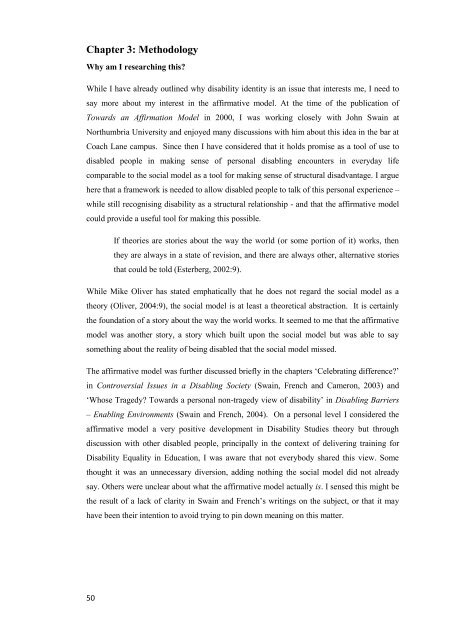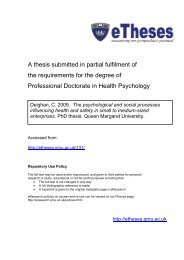A thesis submitted in partial fulfilment of - Etheses - Queen Margaret ...
A thesis submitted in partial fulfilment of - Etheses - Queen Margaret ...
A thesis submitted in partial fulfilment of - Etheses - Queen Margaret ...
You also want an ePaper? Increase the reach of your titles
YUMPU automatically turns print PDFs into web optimized ePapers that Google loves.
Chapter 3: Methodology<br />
Why am I research<strong>in</strong>g this?<br />
While I have already outl<strong>in</strong>ed why disability identity is an issue that <strong>in</strong>terests me, I need to<br />
say more about my <strong>in</strong>terest <strong>in</strong> the affirmative model. At the time <strong>of</strong> the publication <strong>of</strong><br />
Towards an Affirmation Model <strong>in</strong> 2000, I was work<strong>in</strong>g closely with John Swa<strong>in</strong> at<br />
Northumbria University and enjoyed many discussions with him about this idea <strong>in</strong> the bar at<br />
Coach Lane campus. S<strong>in</strong>ce then I have considered that it holds promise as a tool <strong>of</strong> use to<br />
disabled people <strong>in</strong> mak<strong>in</strong>g sense <strong>of</strong> personal disabl<strong>in</strong>g encounters <strong>in</strong> everyday life<br />
comparable to the social model as a tool for mak<strong>in</strong>g sense <strong>of</strong> structural disadvantage. I argue<br />
here that a framework is needed to allow disabled people to talk <strong>of</strong> this personal experience –<br />
while still recognis<strong>in</strong>g disability as a structural relationship - and that the affirmative model<br />
could provide a useful tool for mak<strong>in</strong>g this possible.<br />
50<br />
If theories are stories about the way the world (or some portion <strong>of</strong> it) works, then<br />
they are always <strong>in</strong> a state <strong>of</strong> revision, and there are always other, alternative stories<br />
that could be told (Esterberg, 2002:9).<br />
While Mike Oliver has stated emphatically that he does not regard the social model as a<br />
theory (Oliver, 2004:9), the social model is at least a theoretical abstraction. It is certa<strong>in</strong>ly<br />
the foundation <strong>of</strong> a story about the way the world works. It seemed to me that the affirmative<br />
model was another story, a story which built upon the social model but was able to say<br />
someth<strong>in</strong>g about the reality <strong>of</strong> be<strong>in</strong>g disabled that the social model missed.<br />
The affirmative model was further discussed briefly <strong>in</strong> the chapters „Celebrat<strong>in</strong>g difference?‟<br />
<strong>in</strong> Controversial Issues <strong>in</strong> a Disabl<strong>in</strong>g Society (Swa<strong>in</strong>, French and Cameron, 2003) and<br />
„Whose Tragedy? Towards a personal non-tragedy view <strong>of</strong> disability‟ <strong>in</strong> Disabl<strong>in</strong>g Barriers<br />
– Enabl<strong>in</strong>g Environments (Swa<strong>in</strong> and French, 2004). On a personal level I considered the<br />
affirmative model a very positive development <strong>in</strong> Disability Studies theory but through<br />
discussion with other disabled people, pr<strong>in</strong>cipally <strong>in</strong> the context <strong>of</strong> deliver<strong>in</strong>g tra<strong>in</strong><strong>in</strong>g for<br />
Disability Equality <strong>in</strong> Education, I was aware that not everybody shared this view. Some<br />
thought it was an unnecessary diversion, add<strong>in</strong>g noth<strong>in</strong>g the social model did not already<br />
say. Others were unclear about what the affirmative model actually is. I sensed this might be<br />
the result <strong>of</strong> a lack <strong>of</strong> clarity <strong>in</strong> Swa<strong>in</strong> and French‟s writ<strong>in</strong>gs on the subject, or that it may<br />
have been their <strong>in</strong>tention to avoid try<strong>in</strong>g to p<strong>in</strong> down mean<strong>in</strong>g on this matter.




